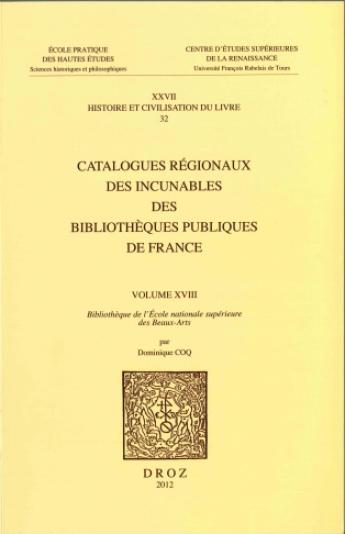Syndicat National de la Librairie Ancienne et Moderne
SLAM Bibliography Prize 2013

The SLAM Bibliography Prize 2013 goes to:
Catalogues régionaux des incunables des bibliothèques publiques de France. Volume XVIII. Bibliothèque de l'École nationale supérieure des Beaux-Arts. Édité par Dominique Coq. Collection Histoire et civilisation du livre. École Pratique des Hautes Études (EPHE). Genève, Librairie Droz, 2012. 334 p., ill.
Established in 1979, the series of “Catalogues régionaux des incunables des bibliothèques de France” (CRI) has now been continued with the 13th volume, edited by Dominique Coq and published in 2012. It stands together with the “Catalogue des incunables de la Bibliothèque Nationale”. The CRI is a general census of the books printed in the “Gutenberg era” from the year 1455 to 1500 which are kept in public collections in France. Under the scientific guidance of the Centre d'études supérieures de la Renaissance the project contributes widely to the understanding of the French cultural heritage.
The “Catalogues régionaux des incunables des bibliothèques de France” provides detailed bibliographical descriptions: provenance, binding, writers, illuminators … Very often these descriptions are a valuable addition to the, in many cases, incomplete information provided by the public libraries and collections in which the volumes are kept.
The CRI does not only give scholars and scientists access to the very rare and precious documents, it also allows a wider public to explore the diversity of forms, content and origins of those books printed between 1455 and 1500. Those incunabula contain the knowledge of that time, they were products of the first presses located in many European cities, and as such they reflect the intellectual, cultural, economic and social conditions at the dawn of the Renaissance. In gathering all information about those printed witnesses of the Gutenberg era, the CRI has been preserving and documenting this written heritage of French culture for more than 30 years now.
>>> For more information, please visit the SLAM website.
